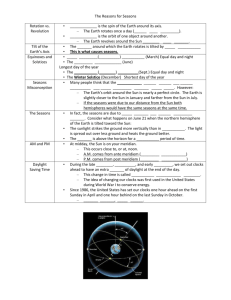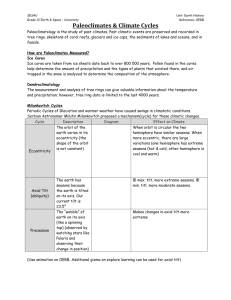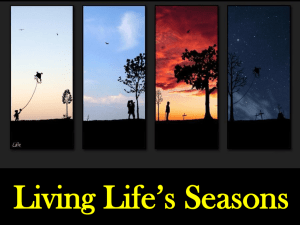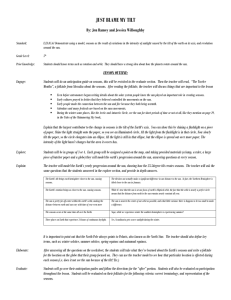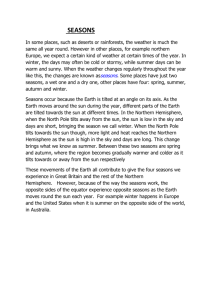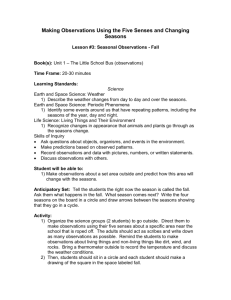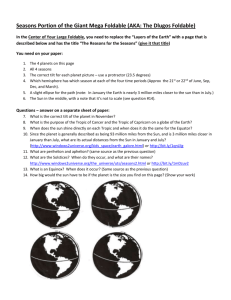UT Standards Academy Lesson Plan Template: How Angle Affects
advertisement
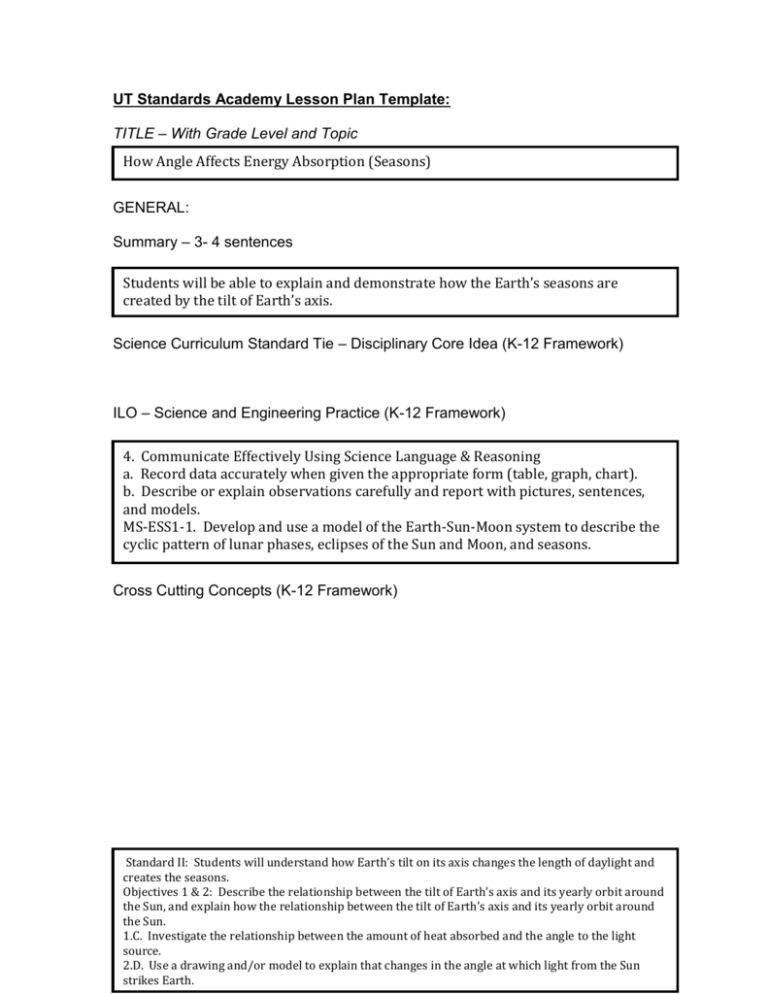
UT Standards Academy Lesson Plan Template: TITLE – With Grade Level and Topic How Angle Affects Energy Absorption (Seasons) GENERAL: Summary – 3- 4 sentences Students will be able to explain and demonstrate how the Earth’s seasons are created by the tilt of Earth’s axis. Science Curriculum Standard Tie – Disciplinary Core Idea (K-12 Framework) ILO – Science and Engineering Practice (K-12 Framework) 4. Communicate Effectively Using Science Language & Reasoning a. Record data accurately when given the appropriate form (table, graph, chart). b. Describe or explain observations carefully and report with pictures, sentences, and models. MS-ESS1-1. Develop and use a model of the Earth-Sun-Moon system to describe the cyclic pattern of lunar phases, eclipses of the Sun and Moon, and seasons. Cross Cutting Concepts (K-12 Framework) Standard II: Students will understand how Earth’s tilt on its axis changes the length of daylight and creates the seasons. Objectives 1 & 2: Describe the relationship between the tilt of Earth’s axis and its yearly orbit around the Sun, and explain how the relationship between the tilt of Earth’s axis and its yearly orbit around the Sun. 1.C. Investigate the relationship between the amount of heat absorbed and the angle to the light source. 2.D. Use a drawing and/or model to explain that changes in the angle at which light from the Sun strikes Earth. Patterns: Observed patterns of forms and events guide organization and classification, and they prompt questions about relationship and the factors that influence them. Cause & Effect—Mechanism & Explanation: Events have causes, sometimes simple, sometimes multifaceted. A major activity of science is investigating and explaining casual relationships and the mechanisms by which they are mediated. Such mechanisms can then be tested across given contexts and used to predict and explain events in new contexts. Systems and System Models: Defining the system under study—specifically its boundaries and making explicit a model of that system—provides tools for understanding and testing ideas that are applicable throughout science and engineering. Math and/or ELA Curriculum Tie RST.6-8.7: Integrate quantitative or technical information expressed in words in a text with a version of that information expressed visually (e.g. in a flow chart, diagram, model, graph, or table). WHST.6-8.2: Write informative/explanatory texts to examine a topic and convey ideas, concepts, and information through the selection, organization, and analysis of relevant content. SL.8.5: Include multimedia components and visual displays in presentations to clarify claims and findings and emphasize salient points. MP.2: Reason abstractly and quantitatively. 7.RP.A.2: Recognize and represent proportional relationships between quantities. Time Frame: Number of Class Periods – Number of Minutes 2 45-minute sessions (90 minutes total) Group Size Groups of 2-4 students highered.mcgrawhill.com/sites/007299181x/student_view0/chapter2/seasons_interactive.html ****Look for similar apps/applets**** Earth Science Interactive Glossary (iPad app) “Axial Tilt” video “The Days and Seasons” video Technology Tools Utilized Bibliography highered.mcgrawhill.com/sites/007299181x/student_view0/chapter2/seasons_interactive.html Key Words Earth’s tilt (23.5 degrees), seasons, axis, rotation, revolution, orbit INSTRUCTIONAL: Materials – Quantity and Vendor if necessary Graphing Worksheet*** Graph paper (at least 2 pieces for each student) Skittles (a snack pack—or 20 pieces—per group) --base ten blocks, m&m’s, dry beans, etc. can also be used flashlights (1 for each group) protractor (1 for each group) ruler (1 for each group) reading lamp (at least one—you can demo, or have students work in groups) tape (to attach the flashlight to the ruler) Background for Teachers – Website Links or Specific Content highered.mcgrawhill.com/sites/007299181x/student_view0/chapter2/seasons_interactive.html Clark Planetarium Seasons Kit BrainPop also has a Seasons video which could substitute the app videos if you have an account. Astronomy. Org-The Reasons for Seasons Science-class.net/archive/science-class/Astronomy/Seasons.htm thesciencequeen.net/teachers%20resources.htm Student Prior Knowledge Students will need to know how to use a protractor and a ruler. Students will also need to have a basic understanding of Earth’s revolution around the Sun. Instructional Procedure Teacher Preparation 1. Have worksheets prepared. 2. Gather all necessary materials (check flashlight batteries, etc.). Performance Task 1. Have students answer the following question in their Science Journal: What do you think causes seasons to change? 2. Give students table talk time (or think-pair-share) afterward. 3. Tell students the following activities are going to help them better understand why we have different seasons. 4. Graphing Activity (addresses Earth’s average distance from the Sun during each month) **create worksheet** a. Give students data sheet and have them work together to create a bar graph and a line graph depicting the data correctly. b. Then, instruct students to create one of the graphs using an online tool like Http://nces.ed.gov.nceskids/createagraph/default.aspx c. Discussion (outlined below) d. Students will use this graph as supporting evidence to the following questions: i. In what month was Earth closest to the Sun? ii. In what month was Earth farthest from the Sun? iii. What are the seasons during those two months? iv. When it’s winter here, what is the weather like is Australia? v. Does this surprise you? Why/Why not? vi. What can you conclude about Earth’s distance from the Sun in relation to the seasons? 5. Reading Lamp Observation (addresses tilt, direct & indirect rays) a. Students will place their hand directly under the reading light. b. Teacher asks, “How could you decrease how hot your hand feels under the light?” (expect responses like moving your hand farther away, but explain that with the graphing activity, this was not the case, so think of another way to reduce the heat absorption) c. Allow students time to explore and come up with their hypotheses. 6. Flashlight & Graph Paper Exploration (addresses tilt, direct & indirect rays) a. Students will use the knowledge they acquired from the Graph Activity and the Reading Lamp Observation to test their hypotheses. b. First, give students a flashlight, ruler, and the tape. c. Instruct students to attach the flashlight to the ruler using a set distance (for example, attach the flashlight so the base of the flashlight is at the 5” line). d. Emphasize to students that we previously found that distance was not causing the change in heat absorption on Earth, so we are controlling this variable. e. Students will also need direction as to what data to collect. i. Sketches of lab set-up/data ii. Measurements iii. Areas of circle and ellipses (by counting squares on the graph paper) iv. Photos with personal devices 7. Skittles & Energy Distribution Activity (addresses tilt, direct & indirect rays) a. Give each group 20 Skittles and instruct them to hold their flashlight at 90 degrees. Spread the Skittles evenly throughout the area. b. Then, have the students repeat this process with two lower angles (like 60 degrees and 40 degrees). c. Discuss with students that the amount of energy is not changing, but the area is more spread out, so the particles (light energy) are farther apart. d. Finally, instruct students to repeat the process, but with 10 different data points (angles) and record their data using one of the following platforms: ***Create a rubric for this assessment*** i. Photos with personal devices ii. Splice (iPad) iii. Explain Everything (cheap) iv. EduCreations/Whiteboard/Show Me are whiteboard apps which copy pen strokes v. Prezi vi. Instructional video 8. Wrap-Up Video a. Show one of the selected videos from the Earth Science Glossary app or Brain Pop. b. Have students write a well-constructed paragraph in their Science Journal about the comparing the amount of light energy absorbed during winter and summer months in the Northern Hemisphere. Strategies for Diverse Learners Give students the accommodation when needed to either illustrate their findings or use bullet points rather than a paragraph in their Science Journal for Wrap-Up Video at the end. Extensions For extensions/advanced learners, have the student complete the “Exercises” tab on the highered.mcgrawhill.com/sites/007299181x/student_view0/chapter2/seasons_interactive.html site. ASSESSMENT: Assessment Plan Pre-Assessment – Pre-write in Science Journal; students were also given the opportunity to share with their peers. Formative – Graphing Activity, Observations & Hypotheses from the Lamp Activity, Data from the Flashlight & Graph Paper Exploration Summative – Skittles Activity Product, Paragraph in Science Journal Assessment Rubric – ***Skittles Activity Product ***Paragraph

